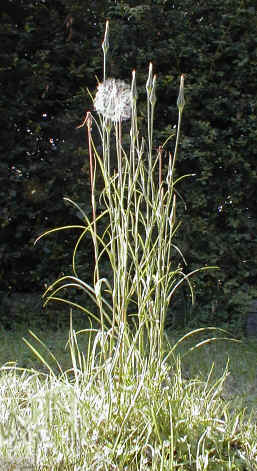 |
"Goat's Beard" Clock
An illustrated peep at the structure of this plant's seed dispersal mechanism By Paul James, UK
 |
Goat's Beard, ( Tragopon pratensis, and T. dubius ) a medium sized annual/perennial, and member of the Compositae or Daisy family is not classified as being a rare flower in the UK, but I usually find no more than about 2 or 3 examples of these curious plants around our patch each year.
The name Goat's Beard comes from the pappus/seed arrangement after flowering which, referred to as the 'clock' for more obvious reasons, vaguely resembles the beard.
"Jack-go-to-bed-at-noon", an old folk name sums up the curious behaviour of the flower head very well, since the flower only fully opens on bright sunny mornings. During dull spells the flower head rarely opens and the plant remains almost inconspicuous, camouflaged well in tall grass. I doubt whether many people with a casual approach to matters of nature will have noticed them.
In full early sunlight the flower does open to reveal a head surrounded by long sepal-like bracts, around a flattened dandelion-like whorl of yellow florets, which close a few hours later.
Closing late am. The appeal of this plant I think is after pollination when the pappus develops the 'beard' or 'clock', for the arrangement is much larger than a dandelion's though at first glance duller and less dense, owing to the much larger seeds and fewer parachutes. These aerial seed transporters are quite a delight to the eye, and even more so through a glass.
Seeds showing parachutes with new upward curving tops
Interesting comparison with dandelion's seedling
The entire assembly of the individual seed unit is about 25-30mm in height and averaging 35mm in diameter for the umbrella, so they can be handled individually and inspected with ease. When dropped they fall gracefully and slowly, and I'd expect they would travel a fair distance in a breeze. Close up they are intricate, and when inspected through a loupe, the umbrella can be seen to be a little more sophisticated than the seed umbrellas of their cousins the dandelion. Apparently 'woven' throughout the radial limbs of the parachute is a layer of delicate thread-like woolly material, evolved no doubt to increase aerodynamic resistance as the seed falls, and potentially carrying it further a field. Though appearing cobweb-like, closer scrutiny reveals that the way these strands of fibre are produced is more complex than at first glance.
Crudely resembling a spider's web, the parachute appears to be formed from thread-like material dissimilar to the radial supports, but closer examination reveals that the origin of each fibre is the radial arm itself.
Further observation at high power shows the true nature of the origins of the delicate threads.
x400 Darkground Illumination. Radial arm. The threads can be clearly seen to originate from the cellular mass of the radial
arm. Their tangental contact angle suggest that they are formed from the
peeling off of the outer layers of fibrous cells of the radial arm.
So what at first appears to be a separate and very delicate mat of cellular tissue, is in fact a series of singularly developed strands of the same cellulose fibre from which the radial arms are formed. One of the many wonders of nature is how both the radial arms and mat are formed in sequence in the developing pappus.
x200 Darkground illumination Radial Arm
Projections from the radial rods which resemble 'hooks' of some kind can be clearly seen above, but few radial axes were found with them. Whether they have evolved for a purpose, or are artefacts I cannot say but they would certainly help to contain the fibre matting within the plane of the parachute.
All photo's taken with Olympus 830L, some using supplementary lenses.
Photomicroscopy using Wild M20/830L
All comments welcome to Paul James.
Published in the October 2000 edition of Micscape Magazine.
Please report any
Web problems or offer general comments to the Micscape Editor,
via the contact on current Micscape Index.
Micscape is the
on-line monthly magazine of the Microscopy UK web
site at Microscopy-UK